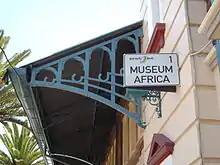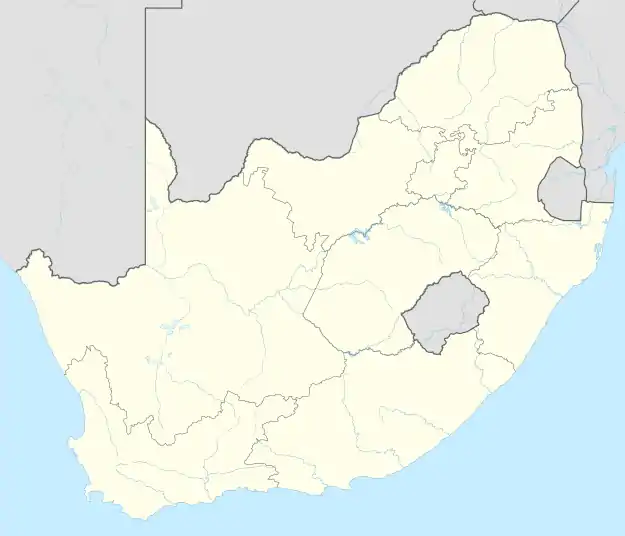MuseuMAfricA
Museum Africa or MuseuMAfricA (formerly known as the Africana Museum) is an historical museum in Newtown, Johannesburg, South Africa.
 Sign at the entrance to the Museum Africa | |
 Johannesburg Central Location within South Africa | |
Former name | Africana Museum (1935-1994) |
|---|---|
| Established | 1933 |
| Location | Newtown, Johannesburg, South Africa |
| Coordinates | 26.2018684°S 28.0323377°E |
| Website | Museumwebsite |
History
The museum was established in 1935, when the Johannesburg Public Library bought a large quantity of Africana material and books from John Gaspard Gubbins.[1] From the mid-1930s, the museum's scope widened to include all aspects of African cultural history and material culture.
The museum regularly published catalogues of the Africana it had in its collections, with titles such as "Military medals of South African interest", "Artists' impressions of Johannesburg, 1886-1956" and "Claudius water-colours in the Africana Museum".[2] From 1943 to 1993 the museum also published the quarterly journal Africana Notes and News.[3]
The museum established the following branch museums: James Hall Museum of Transport, 1964; Bensusan Photographic Museum and Library, 1969; The Museum of South African Rock Art, 1969; and the Bernberg Museum of Costume, 1973. In 1978, it took over the Museum of Man and Science.[3]
In 1994, after the fall of apartheid and the election of a representative democratic government in South Africa, the museum was refurbished and renamed MuseuMAfricA.
MuseuMAfrica launched an exhibit entitled "Never, never again" which led to the establishment of the Hector Pieterson Museum in Soweto. The Apartheid Museum in Gold Reef City was created and run by Christopher Till, former head of the Africana Museum.[3]
Location
The museum is housed in the city's former fruit and vegetable market in Newtown, built in 1913, located opposite Mary Fitzgerald Square, on the same block as the Market Theatre.
Collections
The museum has collections of African material culture from across the continent, including noted collections of tokens, musical instruments and head-rests.
Permanent exhibitions include MyCulture which outlines the different South African cultural and ethnic groups, their origins and how these groups have changed over time;[4]Johannesburg Transformations, highlighting the momentous changes that the city has undergone in its history;[5] and Tried for Treason an exhibition detailing the Rivonia Trial involving 156 defendants, including Nelson Mandela.
The Bensusan Museum of Photography collects rare and valuable precision-made photographic equipment, some dating from the Victorian and Edwardian eras[4] and pictures made using this equipment including wet-plate prints, stereoscopic views and digital images.
The Geology Museum collection consists of over 17 000 rock and mineral samples from Southern Africa, including from the Tsumeb area of Namibia (an area with diverse mineral deposits), the Witwatersrand reefs (a gold mining area), and the Okiep area (a copper mining region).
The Workers' Museum, located two blocks away opposite the Sci-Bono Discovery Centre, is a branch of the museum which tells the story of the migrant labourers who came from across Southern Africa and other parts of the world to work in the gold mines of Johannesburg.[4]
Controversies
As with most publicly funded South African museums, Museum Africa is poorly resourced and inadequately managed. The government art and culture structures which are supposed to manage the museums at a provincial level are slow and unresponsive, resulting in the slow destruction of heritage buildings. Museum Africa is not exempt from this fate and is a poor state of repair. There are suggestions that privatisation of South African museums is the only way to ensure their survival.[6][7][8]
COVID-19 lockdown theft
During the level 1 lockdown imposed on South Africa during the 2020 COVID-19 pandemic, museums were closed along with all such public buildings.[9] The lockdowns and curfews presented criminals with opportunities to access these buildings as, in many cases, they were not adequately secured. One such robbery occurred in November 2020, during which no artefacts from the museum were taken but water tap fittings and basins were removed, resulting in partial flooding of the museum and possible damage to stored exhibits.[10]
References
- Byala, Sara G. (2013). A place that matters yet : John Gubbins's MuseumAfrica in the postcolonial world. Chicago: The University of Chicago Press. ISBN 9780226030302.
- OpenLibrary.org (1 April 2008). "Africana Museum (Johannesburg, South Africa)". Open Library. Retrieved 18 December 2020.
- Byala, Sara G. (18 March 2010). "The museum becomes archive: reassessing Johannesburg's MuseumAfrica". Social Dynamics: A Journal of African Studies. 36 (1): 11–23. doi:10.1080/02533950903561171.CS1 maint: date and year (link)(subscription required)
- "Museum Africa - Gauteng Tourism Authority". Gauteng Tourism Authority. 10 March 2020. Retrieved 18 December 2020.
- "Museum Africa". SA Places. Retrieved 18 December 2020.
- "Jo'burg museums are decaying, but will privatising them create more problems?". The Mail & Guardian. 27 April 2017. Retrieved 18 December 2020.
- Alfred, Luke (14 April 2016). "Museum Africa: Neglected charm". BusinessLIVE. Retrieved 18 December 2020.(subscription required)
- "A rich history archive has been left to rot". The Mail & Guardian. 28 February 2016. Retrieved 18 December 2020.
- "Coronavirus COVID-19 Alert level 1". South African Government. Retrieved 18 December 2020.
- Bhengu, Lwandile (4 November 2020). "City of Joburg to beef up security following attempted robbery at museum". News24. Retrieved 18 December 2020.